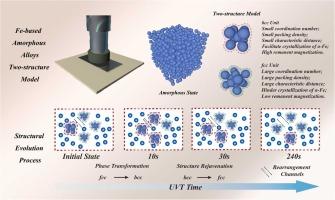超声振动处理下铁基非晶合金的结构演化与结晶动力学
IF 6.3
2区 材料科学
Q2 CHEMISTRY, PHYSICAL
引用次数: 0
摘要
铁基非晶合金由于其独特的软磁性能和能带结构,广泛应用于滤波器、低频机械天线、废水处理等各个领域。目前,采用高温高压灭菌、高能粒子辐照、脉冲激光处理、动态力学松弛等表面处理方法来优化铁基非晶合金的结构,提高其性能。超声振动治疗(UVT)因其能量的集中和快速应用而备受关注,常被用作激光治疗的辅助方法。本文将UVT直接应用于非晶合金,通过改变UVT时间来控制总能量输入。x射线衍射和TEM选区电子衍射的对分布函数结果表明,UVT可以通过促进bcc和fcc/rcp单元之间根据双结构模型的相互转换来精细调节和恢复铁基非晶合金的结构。此外,采用差示扫描量热法(DSC)研究了UVT对非晶合金结晶动力学的影响。样品中mu -10具有最多的cc单位和最高的活化能。发现UVT主要影响晶体生长阶段,而不影响“瞬时成核-低维生长”结晶过程,从而影响铁基非晶合金的软磁和磁致伸缩性能。测得的mu -240的结构、热、磁参数有向初始阶段恢复的趋势。UVT对铁基非晶合金的结构进行微调和恢复,为实际应用提供了有价值的控制策略。本文章由计算机程序翻译,如有差异,请以英文原文为准。

Structural evolution and crystallization kinetics of Fe-based amorphous alloys under ultrasonic vibrations treatment
Fe-based amorphous alloys are widely used in various fields such as filters, low-frequency mechanical antennas, and wastewater treatment due to their unique soft magnetic properties and band structure. Currently, several surface treatment methods, including such as high-temperature autoclave processing, high-energy particle irradiation, pulsed laser treatment, and dynamic mechanical relaxation are employed to optimize the structure and enhance the performance of Fe-based amorphous alloys. Ultrasonic vibration treatment (UVT) has gained attention for its concentrated and rapid energy application, often used as an assisted method for laser treatments. In this paper, UVT was applied directly to the amorphous alloys, with the total energy input controlled by varying the UVT time. The results of X-ray diffraction and pair distribution function from selected area electron diffraction of TEM indicate that UVT can finely tune and restore the structure of Fe-based amorphous alloys by facilitating the interconversion between bcc and fcc/rcp units according to the two-structure model. Additionally, the influence of UVT on the crystallization kinetics of the amorphous alloys was investigated by differential scanning calorimetry (DSC). The Mu-10s has the most bcc units and the highest activation energies among the samples. It was found that UVT primarily affects the crystal growth stage and does not influence the 'instantaneous nucleation - low-dimensional growth' crystallization process, which influences the soft magnetic and magnetostrictive properties of Fe-based amorphous alloys. The measured structural, thermal, and magnetic parameters of the Mu-240s show a tendency to recover toward those of the initial stage. The fine-tuning and recovery of the structure of Fe-based amorphous alloys through UVT can provide valuable control strategies for the practical applications.
求助全文
通过发布文献求助,成功后即可免费获取论文全文。
去求助
来源期刊

Journal of Alloys and Compounds
工程技术-材料科学:综合
CiteScore
11.10
自引率
14.50%
发文量
5146
审稿时长
67 days
期刊介绍:
The Journal of Alloys and Compounds is intended to serve as an international medium for the publication of work on solid materials comprising compounds as well as alloys. Its great strength lies in the diversity of discipline which it encompasses, drawing together results from materials science, solid-state chemistry and physics.
 求助内容:
求助内容: 应助结果提醒方式:
应助结果提醒方式:


